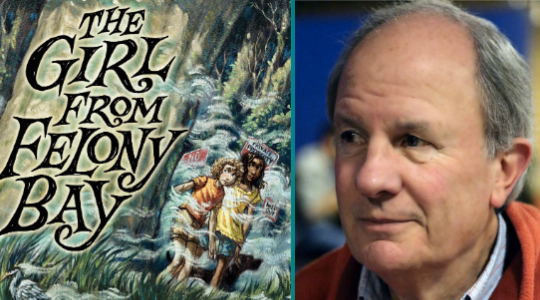Meet “The Girl From Felony Bay” Author J.E. Thompson
2013-04-29
Welcome J.E., and congratulations on publishing your first middle grade novel! Can you share your path to publication?
J.E. Thompson: From the time I first started writing to finishing the manuscript and handing it to my daughter for her approval, it probably took me about 4 months. I tend to work pretty fast, and I write 7 days a week and spend a fair amount of time every day at the computer. Whether I am actually pounding the keys or not, I find that spending time at my desk focuses both the front of my brain (the part that articulates ideas into sentences) and the back of my brain (the part where the ideas really come from) on the task at hand. I might type for a while, then spend time answering emails or making phone calls, then write again for a while, then walk dogs, then write, going back and forth through much of the day. I don’t know if that’s a strange process or not, but it has definitely become my process.
As far as getting to publication, here’s the story: Stephen Barbara at Foundry Media, became my agent a year or two before I wrote The Girl from Felony Bay. We met when my thriller, Armageddon Conspiracy was enjoying a nice run as a SIBA (Southern Independent Booksellers) Finalist for Best Fiction and also IPPY Gold Medal winner for Best Thriller.
A quick word about Foundry—in a publishing world that is being turned topsy-turvy by the advent of e-books and e-readers and self-publishing, etc, etc, Foundry is a group of creative 30-something agents who embrace the new world, and rather than complaining about why it can’t be as easy as it used to be, find ways to be very successful in the current environment. Highly recommended! If any writers are lucky enough to find a home at Foundry they will be well served!
So, back to The Girl from Felony Bay. I gave the manuscript to my daughter with instructions to be very tough. I told her I could keep working on it as long as necessary so that if it wasn’t in the same quality ballpark as the books she had given me to read (see below) she needed to tell me, and she also needed to know that she couldn’t possibly hurt my feelings with a bad review. She gave the manuscript a serious read and said, “Better than three, not as good as two.” Now, she IS my daughter, so I have to cut her a little bit of slack, and I also have to credit the fact that she might have seen a bit of herself in the main character, but after some hard questioning, I took her at her word and sent the manuscript off to Stephen, who loved it.
Why did you decide to write a middle grade story?
J.E.T: I had been writing thrillers aimed at an adult audience, but my 12-year old daughter asked me to write something she could read. I really wanted to honor her request and asked her to give me her favorite 5 books. She gave me: Hoot by Carl Hiaasen, Holes by Louis Sachar, City of Ember by Jeanne DuPrau, The Lightning Thief by Rick Riordan and Hunger Games by Suzanne Collins.
After reading those books, I was hooked on middle grade and YA because the plots and characters were so good and entertaining, and the stories were so original and so much fresher than most adult fiction. Even if I hadn’t made a promise to my daughter, after reading those wonderful books, I would wanted to write in this genre just because it’s so much fun.
What brought you to Walden Pond Press?
J.E.T: My agent submitted The Girl from Felony Bay to a number of excellent Middle Grade publishers, and several wanted to buy the book. In the end, he set up conference calls so that I could speak with the bidding editors, and after speaking with the people at Walden Pond Press and HarperCollins and hearing their excitement about The Girl from Felony Bay, I knew who I wanted to work with. But then, as an added bonus, when Debbie Kovacs [at Walden] told me that Walden Media had done the movies for Hoot, Holes and City of Ember, three of the books that I had read and loved, I was totally hooked! These were clearly people who loved really good Middle Grade books, and I wanted to work with them in a big way.
Tell us about The Girl from Felony Bay, what makes it unique?
J.E.T: The Girl from Felony Bay is a very fast paced mystery with great characters and a wonderful sense of place, but it is also a book that lets readers experience aspects of the South that many don’t know about. For example, in lots of communities African Americans share the same last names with some of the white citizens because they are descendants of slaves once owned by the ancestors of the white family. Also, Heirs’ Property, a type of property created in the immediate aftermath of the Civil War when white plantation owners tried to induce their ex-slaves to stay on the plantation and continue to do the backbreaking agricultural work, still exists today. In many ways history seems more alive in the South than in the North. Perhaps it’s because the South lost the Civil War, perhaps because so much of the war was fought down here and because so many of our houses date back to much earlier times, or perhaps because families here tend to stay put more than they seem to in other parts of the country and live with their family histories. For example, just a few houses south of the one where I live, a man has a cannonball embedded in a beam in his attic. It’s been there for over a hundred and fifty years. I know because I’ve seen it with my own eyes.
How did your experiences growing up influence your writing?
J.E.T: I grew up in the Midwest, in Toledo, Ohio. There were very few old buildings to be seen, and none of the houses where I lived dated back any earlier than 1930. The downtown was the same way, and almost everywhere it seemed as if the entire city wasn’t more than 50 years old. Of course it was much older, but most of the older buildings had been razed to make way for newer ones, and so I had very little sense of anything that came before my grandparents.
When I moved to Charleston and discovered such a wonderful sense on continuity, saw painting in my friends’ living rooms of their ancestors that dated back to the early 1800s and even met people who’s property has been in their family since it was given during the time of King George of England, I wanted to write something that dealt with both the good and bad aspects of that long history.
Growing up in the Midwest influenced my writing in another way, as well. Until I moved to NYC many years later, I never knew anyone who made their living in the arts. I knew no singers, dancers, musicians, choreographers, poets, actors, editors, painters or novelists, and for that reason the arts seemed inapproachable and frightening. Everyone I knew was either in a business where they made something (probably automotive) or they were an accountant, doctor, lawyer or stockbroker, and being afraid that if I tried to be a writer I would end up driving a taxi or bartending for the rest of my life, I chickened out and went to Wall Street. Twenty-five years later, I busted out and started writing full time.
In your opinion, what is the most challenging part of writing for children?
J.E.T: First of all I think it’s dangerous to think about them as ‘children’ because it suggests that they are simplistic. The books I’ve read that are doing well in the Middle Grade space are anything but simplistic. They are all well written, well structured and fast paced with characters that draw the reader. In short, they are darn good novels, which means that writing for these ‘children’ is as taxing and demanding as writing for any other group of discerning readers.
What were your favorite books as a kid?
J.E.T: The Hardy Boys, of course, also, the Oz books by L. Frank Baum, everything Jack London ever wrote, Andre Norton for sci-fi, and Leon Uris.
Do you visit schools to speak about your books? Do you Skype with classrooms? Where can interested parties find more information about setting up a visit with you?
J.E.T: I really like talking to kids, teachers and librarians about my books, and also about their writing and writing in general. I am very open to visits either in person or by Skype, depending on distance.
I can be reached at: jet122949@mac.com. Please feel free to contact me any time.
What are you working on next?
I’m working on a sequel to The Girl from Felony Bay called Finding Yemassee, and also on a Middle Grade fantasy called Bone Warrior.




